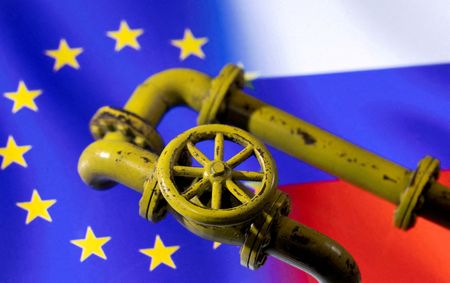
By Nina Chestney
LONDON (Reuters) – Russian gas flows to Europe via Ukraine fell by a quarter on Wednesday after Kyiv halted use of a major transit route blaming interference by occupying Russian forces, the first time exports via Ukraine have been disrupted since the invasion.
Ukraine has remained a major transit route for Russian gas to Europe even after Moscow launched what it calls a “special military operation” on Feb. 24.
The transit point Ukraine shut usually handles about 8% of Russian gas flows to Europe, although European states said they were still receiving supplies. The Ukraine corridor mostly sends gas to Austria, Italy, Slovakia and other east European states.
Kremlin-controlled Gazprom, which has a monopoly on Russian gas exports by pipeline, said it was still shipping gas to Europe via Ukraine, but volumes were seen at 72 million cubic metres (mcm) on Wednesday, down from 95.8 mcm on Tuesday.
GTSOU, which operates Ukraine’s gas system, said on Tuesday it would suspend flows through the Sokhranovka transit point, which it said delivered almost a third of fuel piped from Russia to Europe via Ukraine.
GTSOU said it was declaring “force majeure”, invoked when a business is hit by something beyond its control, and proposed diverting deliveries for Europe to another route, the Sudzha entry point, the biggest of Ukraine’s two crossing points.
GTSOU Chief Executive Sergiy Makogon said Russian occupying forces had started taking gas and sending it to Russia-backed separatist regions in east Ukraine. He did not cite evidence.
The gas pipeline via the Sokhranovka point runs through Ukraine’s Luhansk region, part of which has been under control of pro-Russian separatists. Sudzha lies further north-west.
Kremlin spokesman Dmitry Peskov said Russia remained committed to deals to supply gas, when asked to comment on the row with Ukraine over the transit route. He said Gazprom had not received advance notice of Ukraine’s move.
Gazprom did not immediately respond to a request for comment on Wednesday but had said on Tuesday it saw no proof of force majeure or obstacles to normal flows. It said it was continuing to meet its obligations to supply gas.
Gas flows via Ukraine had been normal until Tuesday and on Monday had reached their highest level since November.
REPLACING RUSSIAN FLOWS
Wednesday’s disruption drove Europe’s benchmark gas price for the third quarter up to 100 euros per megawatt hour at the market open before slipping back. The price is more than 250% above its level a year ago. [NG/GB]
Gazprom said on Tuesday it was not technically possible to shift all volumes to the Sudzha route, as GTSOU proposed.
GTSOU said volumes had been diverted to Sudzha in October 2020 when repairs were carried out on the Sokhranovka route. At that time, it said Sudzha handled 165.1 mcm a day – much more than Tuesday’s total flows through Ukraine of 95.8 mcm.
“Consequently, claims that it is impossible to carry out the transfer of flows from Sokhranovka to Sudzha point are untrue,” GTSOU said in a statement on Facebook.
Most European countries have cut reliance on Russian gas in recent years. Some countries have alternative sources of supply, although replacing all Russian flows presents a challenge given the global gas market was tight even before the Ukraine war.
Italy, which last year consumed 76 billion cubic metres (bcm) of gas, imported about 40% from Russia via Ukraine. Besides Russian flows, Italy also has pipeline connections for gas from Algeria, Libya, Azerbaijan and the North Sea.
Slovak Economy Minister Richard Sulik said the flow of gas to Slovakia from Ukraine was stable and there were no signs of a supply problem, Economy Minister Richard Sulik said
Austrian energy group OMV said its gas deliveries were running according to requests.
Alongside the Ukraine transit corridor, Europe also receives gas via Poland through the Yamal-Europe pipeline and via the Nord Stream 1 pipeline under the Baltic Sea to Germany.
Germany, Europe’s biggest economy and one the region’s heaviest users of Russian gas, said its gas supply was secure.
European Union gas stocks are now about 37% full, according to Gas Infrastructure Europe data.
“That said, storage facilities are still less amply filled than usual,” said Barbara Lambrecht, energy analyst at Commerzbank Research, adding that any interruptions to supply could slow the refilling process.
(Reporting by Reuters, Nina Chestney, Tom Balmforth, Stephen Jewkes, Robert Muller, Markus Wacket, Vera Eckert; Editing by Christopher Cushing and Edmund Blair)

